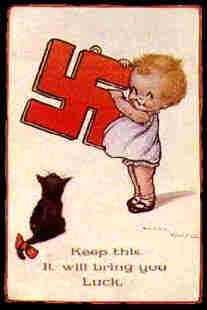Of limousines and condoms
Published Monday, October 24, 2005 by le grand monstre.
We all know about Étienne Charles de Loménie de Brienne, the finance minister guys who succeeded Calonne. Besides a remarkably long name, he was a rather boring and uninteresting man, not worth remembering in general.
Well, Brienne certainly got a thing for bombastic names, if we dig a little deeper, we find that Brienne was from a old noble family who were dukes of a region called Limousin. And in case you are wondering, yes, the limousine car is named after the region because the inhabitants wore a hood with a profile perceived to be similar to that of the car.
Also noteworthy is that before he entered politics, Brienne was flirting around with the clergy, he obtained a doctorate in theology and with a visit to the Pope in 1760, he was conferred the title Bishop of Condom, how bout that huh. In case you are entertaining filthy thoughts, Condom is really just a boring uninteresting town somewhere in France, however, given the more widespread social use in the English language, of the word Condom , it is interesting to note that the town is located on the river Baïse; baise (without the diaeresis), which is a French vulgarism for a sex act.
Anyway, after his stint as a politician, Brienne later got promoted to become the Archbishop of Sens. Despite that, he lost his senses and advocated for the Civil Constitution of the Clergy, this led to his subsequent self destruction. Both his past and present conduct made him an object of suspicion to the revolutionaries; he was arrested at Sens on 9th November 1793 , and died in prison, either of an apoplectic stroke or by poison.
Well, Brienne certainly got a thing for bombastic names, if we dig a little deeper, we find that Brienne was from a old noble family who were dukes of a region called Limousin. And in case you are wondering, yes, the limousine car is named after the region because the inhabitants wore a hood with a profile perceived to be similar to that of the car.
Also noteworthy is that before he entered politics, Brienne was flirting around with the clergy, he obtained a doctorate in theology and with a visit to the Pope in 1760, he was conferred the title Bishop of Condom, how bout that huh. In case you are entertaining filthy thoughts, Condom is really just a boring uninteresting town somewhere in France, however, given the more widespread social use in the English language, of the word Condom , it is interesting to note that the town is located on the river Baïse; baise (without the diaeresis), which is a French vulgarism for a sex act.
Anyway, after his stint as a politician, Brienne later got promoted to become the Archbishop of Sens. Despite that, he lost his senses and advocated for the Civil Constitution of the Clergy, this led to his subsequent self destruction. Both his past and present conduct made him an object of suspicion to the revolutionaries; he was arrested at Sens on 9th November 1793 , and died in prison, either of an apoplectic stroke or by poison.
WHOOPIE!!!
Published Thursday, October 13, 2005 by wackiac.
Exams are finally over for most of you. For the Art students, all the best! You can breathe. For now. Hehehe...
A continuation about the Swastika
Published Monday, October 10, 2005 by amanda faith.
Some definitions I dug out about the Swastika:
1) From dictionary.comSuch a symbol with a clockwise bend to the arms, used as the emblem of the Nazi party and of the German state under Adolf Hitler, officially adopted in 1935.
2) An ancient cosmic or religious symbol formed by a Greek cross with the ends of the arms bent at right angles in either a clockwise or a counterclockwise direction.
3) [Sanskrit svastika, sign of good luck, swastika, from svasti, well-being. See (e)su- in Indo-European Roots.]
Modern day fact:
Swastika is a small community founded around a mining site in northern Ontario, Canada, and today within the municipal boundaries of Kirkland Lake, Ontario.
Swastika is a junction on the Ontario Northland Railway [1], where a branch to Rouyn-Noranda, Quebec leaves the ONR's main line from North Bay, Ontario to Moosonee. The Northlander passenger railway service between Toronto and Cochrane serves a station at Swastika, with connecting bus service to downtown Kirkland Lake.
From wikipedia
The swastika (卐) is an equilateral cross with its arms bent at right angles either clockwise or anticlockwise. It is traditionally oriented so that a main line is horizontal, though it is occasionally rotated at forty-five degrees, and the Hindu version is often decorated with a dot in each quadrant; the un-dotted version is considered more formal in Hinduism.
The swastika is a holy symbol in Hinduism, Jainism and Buddhism. In the West, it is more widely known as the badge of the Nazi movement.
The motif seems to have first been used by early inhabitants of Eurasia. However, it was also adopted in Native American cultures, seemingly independently. The swastika is now used universally in religious and civil ceremonies in India. Most Indian temples, wedding, festivals and celebrations are decorated with swastikas. By the early 20th century it was widely used worldwide, and was regarded as a symbol of good luck and auspiciousness.
Since the rise of the National Socialist German Workers Party, the swastika has been associated with fascism, racism, World War II, and the Holocaust in much of the western world. Before this, it was particularly well-recognized in Europe from the archaeological work of Heinrich Schliemann, who discovered the symbol in the site of ancient Troy and who associated it with the ancient migrations of Indo-European ("Aryan") peoples.[1] Nazi use derived from earlier German völkisch movements, for which the swastika was a symbol of "Aryan" identity, a concept that came to be equated by theorists like Alfred Rosenberg with a Nordic master race originating in northern Europe. The swastika remains a core symbol of Neo-Nazi groups, and is also regularly used by activist groups to signify the supposed Nazi-like behaviour of organizations and individuals they oppose.
For more information, Click on This Report Link to read ^_-
My personal opinion:
People really make too big a deal out of the use of the swastika. So one person messed up the world using that symbol, big deal. Is that less than a decade of terror involving the abuse of an ancient symbol cancel out centuries and milennias of historic symbolism? That just proves how uneducated/ill-informed the general population is about the swastika in general.
As for accusing people who "appear to have Nazi sympathies" of being pro-nazi, seriously, everyone is suppose to have a right to their own opinion and view plus it is not uncommon to have some sympathy for the underdogs of history.
Take world war 1 for example. The Entante and the rest of Europe were all fine about putting the weight of the full fault for world war 1 on the head of Germany and did a pretty good job in washing Germany's dirty laundry. But much is yet to be publisized about their own parts to play. Germany wasn't the only one who seemed 'all out for war' just because they had a large army and all that, every other country involved in world war 1 had their military stocked up as well. How do we know? If the country isn't prepared, there is no way they can go into full mobilization in 3 days.
A side thought: Why is Germany always the one who gets blamed for every large scale war?
And, if World War 1 was also the fault of many other factors and countries, and World War 2 the consequence/continuation from German unhappiness concerning the Treaty of Versailles from World War 1, is Germany really to blame for World War 2 then?
1) From dictionary.comSuch a symbol with a clockwise bend to the arms, used as the emblem of the Nazi party and of the German state under Adolf Hitler, officially adopted in 1935.
2) An ancient cosmic or religious symbol formed by a Greek cross with the ends of the arms bent at right angles in either a clockwise or a counterclockwise direction.
3) [Sanskrit svastika, sign of good luck, swastika, from svasti, well-being. See (e)su- in Indo-European Roots.]
Modern day fact:
Swastika is a small community founded around a mining site in northern Ontario, Canada, and today within the municipal boundaries of Kirkland Lake, Ontario.
Swastika is a junction on the Ontario Northland Railway [1], where a branch to Rouyn-Noranda, Quebec leaves the ONR's main line from North Bay, Ontario to Moosonee. The Northlander passenger railway service between Toronto and Cochrane serves a station at Swastika, with connecting bus service to downtown Kirkland Lake.
From wikipedia
The swastika (卐) is an equilateral cross with its arms bent at right angles either clockwise or anticlockwise. It is traditionally oriented so that a main line is horizontal, though it is occasionally rotated at forty-five degrees, and the Hindu version is often decorated with a dot in each quadrant; the un-dotted version is considered more formal in Hinduism.
The swastika is a holy symbol in Hinduism, Jainism and Buddhism. In the West, it is more widely known as the badge of the Nazi movement.
The motif seems to have first been used by early inhabitants of Eurasia. However, it was also adopted in Native American cultures, seemingly independently. The swastika is now used universally in religious and civil ceremonies in India. Most Indian temples, wedding, festivals and celebrations are decorated with swastikas. By the early 20th century it was widely used worldwide, and was regarded as a symbol of good luck and auspiciousness.
Since the rise of the National Socialist German Workers Party, the swastika has been associated with fascism, racism, World War II, and the Holocaust in much of the western world. Before this, it was particularly well-recognized in Europe from the archaeological work of Heinrich Schliemann, who discovered the symbol in the site of ancient Troy and who associated it with the ancient migrations of Indo-European ("Aryan") peoples.[1] Nazi use derived from earlier German völkisch movements, for which the swastika was a symbol of "Aryan" identity, a concept that came to be equated by theorists like Alfred Rosenberg with a Nordic master race originating in northern Europe. The swastika remains a core symbol of Neo-Nazi groups, and is also regularly used by activist groups to signify the supposed Nazi-like behaviour of organizations and individuals they oppose.
For more information, Click on This Report Link to read ^_-
My personal opinion:
People really make too big a deal out of the use of the swastika. So one person messed up the world using that symbol, big deal. Is that less than a decade of terror involving the abuse of an ancient symbol cancel out centuries and milennias of historic symbolism? That just proves how uneducated/ill-informed the general population is about the swastika in general.
As for accusing people who "appear to have Nazi sympathies" of being pro-nazi, seriously, everyone is suppose to have a right to their own opinion and view plus it is not uncommon to have some sympathy for the underdogs of history.
Take world war 1 for example. The Entante and the rest of Europe were all fine about putting the weight of the full fault for world war 1 on the head of Germany and did a pretty good job in washing Germany's dirty laundry. But much is yet to be publisized about their own parts to play. Germany wasn't the only one who seemed 'all out for war' just because they had a large army and all that, every other country involved in world war 1 had their military stocked up as well. How do we know? If the country isn't prepared, there is no way they can go into full mobilization in 3 days.
A side thought: Why is Germany always the one who gets blamed for every large scale war?
And, if World War 1 was also the fault of many other factors and countries, and World War 2 the consequence/continuation from German unhappiness concerning the Treaty of Versailles from World War 1, is Germany really to blame for World War 2 then?
*ATTENTION TO PU1 STUDENTS*
Published Sunday, October 09, 2005 by wackiac.
EXAM FORMAT
PU1 Combined Paper
Section A: Compulsory SBQ on Political Development of Singapore
Section B: Answer 1 out of 2 questions on Political Impact of Colonial Rule
Section C: Answer 2 out of 3 questions on French Revolution
EXAM TECHNIQUES
• Read the questions CAREFULLY.
• Choose and write out the outlines for the three essays you will be submitting.
• Do not spend more than 45 minutes on any one question (including SBQ) unless you have time to spare (which usually means that you probably didn’t think the question through as well as you should have).
• Make sure that you have spare pens in case your pen runs out of ink. No one’s providing stationery that day.
• Write LEGIBLY. I am not a code-cracker, so do not make me decipher your handwriting.
• Listen carefully when instructions are given. There might be changes made to the question or the way you’re supposed to tie your scripts. Trust me, it can make a world of difference.
ESSAY-WRITING TECHNIQUES
• Write out an outline.
• Remember the importance of structure.
• Each paragraph must contain at most, ONE argument and nothing more.
• Ensure that your arguments are WELL-SUBSTANTIATED.
• For each paragraph, make sure your answer is structured and easy to understand:
1. Topic Sentence (T.S)
2. Explanation of argument made in T.S
3. Support argument with RELEVANT examples
4. Link back to the question
• Look back at the general marking band scheme to see what you need in order to achieve the bands that you are targeting to hit.
SBQ SKILLS
• Please make your INFERENCES clear. Do not simply “quote” or paraphrase the source. You need to EXPLAIN what is contained in the source.
• Support/Debunk the inferences made by the source using contextual knowledge to check its RELIABILITY.
• DO NOT just use provenance to check the reliability of the source. That is just sooo “secondary school”.
• Ensure that your answer is BALANCED, meaning that you should ensure that you address all the sources given and provide good inferences and check the reliability of each.
• If you do all these well, you can be assured of an ‘A’ for SBQ.
PU1 Combined Paper
Section A: Compulsory SBQ on Political Development of Singapore
Section B: Answer 1 out of 2 questions on Political Impact of Colonial Rule
Section C: Answer 2 out of 3 questions on French Revolution
EXAM TECHNIQUES
• Read the questions CAREFULLY.
• Choose and write out the outlines for the three essays you will be submitting.
• Do not spend more than 45 minutes on any one question (including SBQ) unless you have time to spare (which usually means that you probably didn’t think the question through as well as you should have).
• Make sure that you have spare pens in case your pen runs out of ink. No one’s providing stationery that day.
• Write LEGIBLY. I am not a code-cracker, so do not make me decipher your handwriting.
• Listen carefully when instructions are given. There might be changes made to the question or the way you’re supposed to tie your scripts. Trust me, it can make a world of difference.
ESSAY-WRITING TECHNIQUES
• Write out an outline.
• Remember the importance of structure.
• Each paragraph must contain at most, ONE argument and nothing more.
• Ensure that your arguments are WELL-SUBSTANTIATED.
• For each paragraph, make sure your answer is structured and easy to understand:
1. Topic Sentence (T.S)
2. Explanation of argument made in T.S
3. Support argument with RELEVANT examples
4. Link back to the question
• Look back at the general marking band scheme to see what you need in order to achieve the bands that you are targeting to hit.
SBQ SKILLS
• Please make your INFERENCES clear. Do not simply “quote” or paraphrase the source. You need to EXPLAIN what is contained in the source.
• Support/Debunk the inferences made by the source using contextual knowledge to check its RELIABILITY.
• DO NOT just use provenance to check the reliability of the source. That is just sooo “secondary school”.
• Ensure that your answer is BALANCED, meaning that you should ensure that you address all the sources given and provide good inferences and check the reliability of each.
• If you do all these well, you can be assured of an ‘A’ for SBQ.
Swastikas, Scouts and Others
Published by wackiac.
Hehe...I couldn't resist putting up a few more shots. I'd just give brief headings to accompany the shots, alright?
Swastikas and Scouts
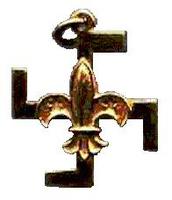

Swastikas and non-Nazi military


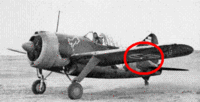
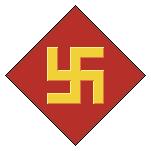
Swastikas and Coca-cola
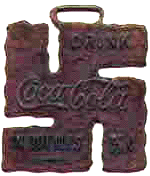

Swastikas and Rudyard Kipling
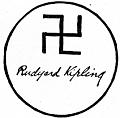

Swastikas and Sports

Oh well, given all that, why do we still insist on Nazi version of the swastika?
Swastikas and Scouts


Swastikas and non-Nazi military




Swastikas and Coca-cola


Swastikas and Rudyard Kipling


Swastikas and Sports

Oh well, given all that, why do we still insist on Nazi version of the swastika?
Swastika
Published Monday, October 03, 2005 by wackiac.
I should think that most of you would have been familiar with the photo of HRH Prince Harry and the whole hoo-haa that ensued. Some time ago, in our very own little island, a similar outcry occurred when a few students decided to name their group after the infamous Hitler. In northern Germany, parents were up in arms when an “innovative” twist to the traditional police-and-thief game became a “Nazi-and-Jew” game with the “Jews” (complete with the Star of David badges), were to try to escape from their “Nazi” captors.
Now, some may be just as outraged with such “Nazi”-inspired acts while others may be inclined to see this as a storm in a teacup. Personally, given the magnitude of destruction that had been caused by Hitler and friends, I’m not surprised by the outrage that such occurrences can and have caused. On the other hand, it’s quite sad to note the effect such negativity has had on things which have been so heavily associated with Nazism, to the point that these things have become just as discriminated against.
An obvious example would be the swastika. For the fun of it, just say the word swastika to someone and note their initial reaction. Most people would immediately respond with “Hitler!” or “Nazi!” Recently, I conducted a mini experiment. I actually drew out a swastika on the class whiteboard. It was not the 45 degree forward facing one that’s associated with Nazism such as the one pictured below.

In fact, it was actually the one pictured below.

Now, there is a distinction to be made here. The Nazi swastika is ALWAYS the tilted one. Any others are not, in any way, associated with Nazism. In spite of that, the uproar that it caused in class was amazing! My dearest History students were flabbergasted that I had actually drawn a swastika and had quickly been shocked to note that their History tutor was possibly a Nazi (I AM NOT!).
While it was amusing, I was also quite disturbed and thus resolved to prove that beyond the tilted one, there is more to the swastika than it being an “evil” symbol.
The swastika in itself, originated eons ago and the word “swastika” is derived from the Sanskrit language. If you want to know what it literally means, feel free to do a google search. Basically, it is meant to be a “good” symbol and was frequently used among many Western countries as a sign of good luck, much like the four-leaved clover. Of course, with the rising power of Nazism, the swastika lost its prominence as a good luck symbol but before that, it was most definitely something which was good.
The following pictures will serve to prove my point further.
The photos below indicate the use of the swastika as a religious symbol.
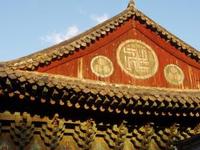
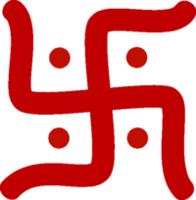

Oooh, and check out the following picture. For something that has become synonymous with anti-Semitism in post-Hitler years, you wouldn't think you'd find swastikas anywhere close to Jews now, would you?
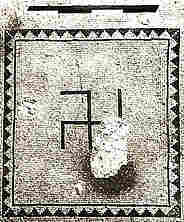

Now, these two swastikas (according to the sources I got them from) were found in ancient synagogues in Israel!
Now, besides the obvious religious connotation in the non-Western world, you might be interested to see the use of the swastika in the Western world. The picture I had attached as part of the earlier post was actually that of postcards that were widely used in pre-Nazi days in Europe. The following shots are other similar postcards containing the offending symbol. You might notice that they share something in common-all the cards indicate wishing the receiver of the card the best of luck!
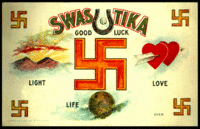


Now, I could go on and on...I've got loads of non-Nazi pictures of swastikas but I thought it'd be fun if you can go look for them. Go on, surf around. Just be sure not to bring in any of these following. Perhaps, I'd add in more swastika inspired shots in another entry.


THESE ARE OBVIOUSLY THE HATE-INDUCING ONES THAT WE NEED TO GET RID OF IN ORDER FOR THE SWASTIKA TO REGAIN A BETTER POSITION IN THE WORLD TODAY.
*ATTENTION TO PU2 STUDENTS*
Published by wackiac.
Folks, you might find the following links useful in understanding a few aspects of world war one:
For those who need to get into the controversies surrounding the causes of war:
1. Causes of WWI
2. German Responsibility of War
3. Balkan Causes of WWI
4. Belgian Neutrality
5. July Crisis
For those who seem to have problems with chronology:
1. Principal Actions
2. Declaring War - Who did what and when??
For those who enjoy statistics and the nitty-gritty stuff:
1. War Plans (for the generals-in-making)
2. Counting Casualties
For those who simply want to read for the fun of it, just click HERE and start surfing around.
For those who need to get into the controversies surrounding the causes of war:
1. Causes of WWI
2. German Responsibility of War
3. Balkan Causes of WWI
4. Belgian Neutrality
5. July Crisis
For those who seem to have problems with chronology:
1. Principal Actions
2. Declaring War - Who did what and when??
For those who enjoy statistics and the nitty-gritty stuff:
1. War Plans (for the generals-in-making)
2. Counting Casualties
For those who simply want to read for the fun of it, just click HERE and start surfing around.
They don't want to know about me
Published by wackiac.
Who would care for Tushar Gandhi if it were not for the Gandhi?
Christie Loh
christie@newstoday.com.sg
HE never met the Mahatma.
.
Yet many regard his stories of India's famous apostle of non-violence as gospel truth — because of his blood ties with Mohandas K Gandhi, the Indian leader whose peaceable calls for the country's independence earned him the Sanskrit honorific of Mahatma, or "great soul".
.
Mr Tushar Gandhi, 45, is the legendary man's great grandson. He attracted media attention in 1996 by fighting a court battle and recovering his ancestor's long-lost ashes, which had been found in a state bank vault. A year later, he founded the Mahatma Gandhi Foundation, one of many similarly inspired organisations worldwide.
.
Don't expect him to practise the ascetic lifestyle of his vegetarian loincloth-wearing ancestor. Mr Tushar Gandhi eats meat, wears jeans and owns a mobile phone.
.
"I don't follow every tenet of Bapu ("Father"). I wish I could, but I don't," Mr Gandhi said, explaining it as his "individuality".
.
Often traversing the globe to give lectures on the Mahatma, he is also writing a book on Gandhi's 1948 assassination.
.
He feels certain politicians have been circulating lies to justify the murder by a Hindu extremist. Determined to dispel criticism, such as that of Gandhi's part in the India-Pakistan divide, Mr Tushar Gandhi has won defamation lawsuits against high-profile figures, including India TV presenter Nikki Bedi.
.
Recently in March, he organised a re-enactment of the Mahatma's famous 1930 Salt March that sparked civil disobedience.
.
He candidly admits that his work to keep the memory of his great grandsire alive is born partly of a "selfish motive".
.
"If the world forgets my great grandfather, then I lose my identity. Because who would care for Tushar Gandhi if it weren't for the Gandhi?" he told Today.
.
He was in Singapore to speak at the inaugural Annual Gandhi Lecture held yesterday to coincide with the late Mahatma's birth anniversary.
.
By his own admission, Mr Gandhi sees himself as "a failed kind of guy" who never made it to university.
.
He has a printing technology diploma, but found the work boring and switched to website designing. Although the latter venture spawned one of India's major electronic archives on Mahatma-related information, Mr Gandhi feels his ancestor's identity overwhelms his own.
.
When invited by lecture organisers to talk about his great grandfather, Mr Gandhi usually gets a fee, sponsored executive-class airfare and accommodation for telling anecdotes he had heard as a child from his grandmother and father.
.
"They don't want to know what I do personally," he said. Most of his time is spent perpetuating the legacy of the Mahatma, who is unrelated to India's former ruling Gandhi family.
.
His grandmother told him when he was a child: "You're like a sapling that's taken root under a massive tree which casts a huge shadow. No matter what you do, you're always going to be under that shadow. It's up to you whether you shrivel up or you thrive."
.
Deciding to do the latter, he signed a licensing deal in 2002 with CMG Worldwide, an American firm that reportedly offered to be the sole agent for the commercial use of Gandhi's name.
.
The agreement was quickly scuttled when an irate Indian media questioned why, among 54 living Gandhi family members, Mr Tushar Gandhi should own the copyright.
taken from www.todayonline.com, Oct 2, 2005
Christie Loh
christie@newstoday.com.sg
HE never met the Mahatma.
.
Yet many regard his stories of India's famous apostle of non-violence as gospel truth — because of his blood ties with Mohandas K Gandhi, the Indian leader whose peaceable calls for the country's independence earned him the Sanskrit honorific of Mahatma, or "great soul".
.
Mr Tushar Gandhi, 45, is the legendary man's great grandson. He attracted media attention in 1996 by fighting a court battle and recovering his ancestor's long-lost ashes, which had been found in a state bank vault. A year later, he founded the Mahatma Gandhi Foundation, one of many similarly inspired organisations worldwide.
.
Don't expect him to practise the ascetic lifestyle of his vegetarian loincloth-wearing ancestor. Mr Tushar Gandhi eats meat, wears jeans and owns a mobile phone.
.
"I don't follow every tenet of Bapu ("Father"). I wish I could, but I don't," Mr Gandhi said, explaining it as his "individuality".
.
Often traversing the globe to give lectures on the Mahatma, he is also writing a book on Gandhi's 1948 assassination.
.
He feels certain politicians have been circulating lies to justify the murder by a Hindu extremist. Determined to dispel criticism, such as that of Gandhi's part in the India-Pakistan divide, Mr Tushar Gandhi has won defamation lawsuits against high-profile figures, including India TV presenter Nikki Bedi.
.
Recently in March, he organised a re-enactment of the Mahatma's famous 1930 Salt March that sparked civil disobedience.
.
He candidly admits that his work to keep the memory of his great grandsire alive is born partly of a "selfish motive".
.
"If the world forgets my great grandfather, then I lose my identity. Because who would care for Tushar Gandhi if it weren't for the Gandhi?" he told Today.
.
He was in Singapore to speak at the inaugural Annual Gandhi Lecture held yesterday to coincide with the late Mahatma's birth anniversary.
.
By his own admission, Mr Gandhi sees himself as "a failed kind of guy" who never made it to university.
.
He has a printing technology diploma, but found the work boring and switched to website designing. Although the latter venture spawned one of India's major electronic archives on Mahatma-related information, Mr Gandhi feels his ancestor's identity overwhelms his own.
.
When invited by lecture organisers to talk about his great grandfather, Mr Gandhi usually gets a fee, sponsored executive-class airfare and accommodation for telling anecdotes he had heard as a child from his grandmother and father.
.
"They don't want to know what I do personally," he said. Most of his time is spent perpetuating the legacy of the Mahatma, who is unrelated to India's former ruling Gandhi family.
.
His grandmother told him when he was a child: "You're like a sapling that's taken root under a massive tree which casts a huge shadow. No matter what you do, you're always going to be under that shadow. It's up to you whether you shrivel up or you thrive."
.
Deciding to do the latter, he signed a licensing deal in 2002 with CMG Worldwide, an American firm that reportedly offered to be the sole agent for the commercial use of Gandhi's name.
.
The agreement was quickly scuttled when an irate Indian media questioned why, among 54 living Gandhi family members, Mr Tushar Gandhi should own the copyright.
taken from www.todayonline.com, Oct 2, 2005
About me
- Every second that passes by is a second that's part of history...
- My profile
